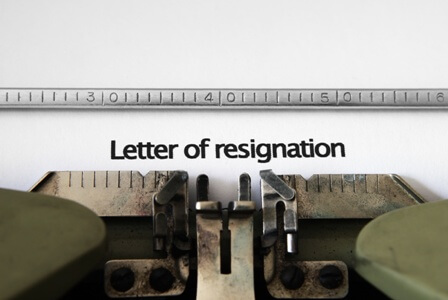We’ve all been there. You have an employee who’s attitude suddenly ‘changes’, they don’t seem to care about their work, take long lunch breaks and have gone ‘cold’. Then one day they approach your office looking nervous, clutching an envelope, or in some cases you receive an email or text out of the blue; a resignation. For some leaders, it’s a relief but mostly it’s a shock.
Initially, we tend to take it personally: “How could he/she do this?”; “How can they let the business down”; “How am I going to explain this to clients”, etc. .. But really, it’s not personal, it’s business. If you operate a small business, or a small team, it can be especially hard to accept. Abrupt departures can be hard on the psyche. If you have grown to rely on that person you may feel that they are deserting you.
Here are some tips to help make the transition as smooth and as amicable as possible:
- Know the Protocol
It’s important to understand your company’s HR procedures for handling resignations. In some larger organisations policy dictates that the moment a person resigns you cut up their key card, pack their desk and escort them out of the building. Elsewhere people are required to work their notice period as stipulated in their contract or award.
- Gauge the situation
The way employees approach their notice period will vary. Some will be unproductive and sour and others will keep up their stellar work until the very last day, professional to the end. I recommend you pay close attention to your employee’s general attitude when they give their resignation. Are they concerned with wrapping up their remaining work or are they bitter and resentful and will openly complain about the workplace/situation/colleagues/managers?
This will help in a couple of ways, firstly it will help you decide how to best announce the departure to both the team and to clients and whether you should call a quick meeting to deliver the message first or leave it up to them to tell the team. A discussion on how they handle their remaining time with the company is essential and you need to set clear expectations from the outset.
- Develop a Transition Plan
Sit down with the employee and develop an exit plan, as their idea may differ to yours. It’s essential that you work collaboratively, make a list of all their regular duties, current projects and clients they keep in direct contact with. Make this list as comprehensive as possible as you will need to decide who will take over these responsibilities when they leave. You should also decide on who will contact the clients, vendors and colleagues so that they are aware of the transition and assured that service will continue in your usual professional manner.
Set a timeline to tie up any loose ends and meet up on their final day to ensure everything has been covered.
- Transfer of Knowledge
Do you know what they know? Before they walk out that door, taking essential information with them, sit down and evaluate what they know that needs to be shared with the team. It may be something as important as knowing an old software system that they support some clients with, or just the level of service they give a particular client. It’s essential to do this as there is nothing worse than finding this out a few weeks after they have left. This is especially important with staff that has been with you for a long time.
- Replace them
Before you jump the gun and start putting adverts everywhere or calling your favourite recruiter, be sure to evaluate the need for a replacement. Once you have done your transfer of knowledge, you will know exactly what this employee does and you will need to compare this with your team’s current priorities, tasks and workload so that you can determine if and when you need to hire a replacement.
For instance, you may realize that their workload is so daunting you will need a temp immediately or in some cases, you may be able to distribute some of the work to other team members until you find a new candidate or you may even realize that now is the time to restructure the position.
In any case, it’s a good idea to commence the hiring process sooner rather than later so within days of receiving the resignation, update the job description, notify your recruiter or HR manager and get ready to start resume reading!
In the end remember that losing this employee is just business and no matter the circumstances, make sure you both leave on good terms. Remain professional at all times, don’t emote (especially when you initially hear about their resignation) and wish them well in their new position. Offer to be a referee and encourage them to keep in touch. Even if their performance wasn’t the best before or during their notice period there is no need to burn that bridge, you never know when you may cross paths again.
Eva Grabner
Managing Director
Elite Executive Pty Ltd
eva@eliteexecutive.com.au
0409 59 11 88

 Posted By: Eva Grabner | on February 29 2016
Posted By: Eva Grabner | on February 29 2016
